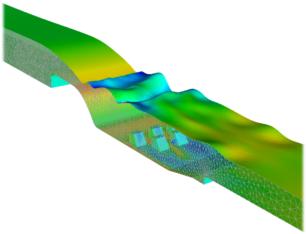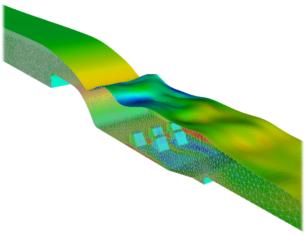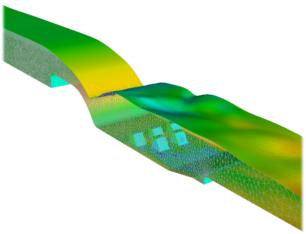


Figure 4: Flow in a spillway: Free surface position and streamwise velocity field at three instants.
Application pages:
|
Figure 4: Flow in a spillway: Free surface position and streamwise velocity field at three instants. |
The stabilized space-time formulation of incompressible flows is applicable to
free surface flow situations, under the constraints typical of interface
tracking methods, in which the domain deformation should remain reasonable,
and joining and folding of the free surface is avoided. The flows past
hydraulic structures such as dams and bridge supports fall into this category.
A goal of this research has been to design robust simulation methods for
flows which are of importance to the U.S. Army Corps of Engineers Waterways
Experiment Station. In addition to the space-time formulation of fluid flow
equations in a variable domain, the set of numerical tools developed here
includes two other important components. They are, a representation of the
kinematic conditions which govern the free surface motion, and, a mesh update
method which provides interior node displacements for any given deformation of
the exterior boundary. The free surface motion in this class of problems may
be best characterized by the surface height equation. The hyperbolic nature of
this equation requires the use of standard stabilization techniques such as
SUPG; moreover, steep wave fronts may have to be controlled via a discontinuity
capturing operator. The movement of the interior nodes of the finite element
mesh can be obtained by treating the mesh as an elastic solid subjected to
prescribed boundary displacements, which are obtained from the discretized
kinematic conditions mentioned above. One approach utilizes mesh
movement equations based on linear elasticity. A more robust approach
takes into account geometric and constitutive nonlinearities and uses
hyperelastic stress-strain relations. The resulting method has been used to
compute the flow in a spillway of the Olmsted dam on the Ohio river.
The model of the spillway includes underwater energy dissipators and a long
stilling basin. In the simulation, the initial condition of flat water
surface quickly gives way to a quasi-steady pattern of hydraulic jumps
and waves which has been satisfactorily compared with experimental results.
The position of the free surface, as well as the color-coded streamwise
velocity field, is shown at three equally-spaced instants in Figure 4.
An infrequent regeneration of the finite element mesh is sometimes
necessitated by the large distortion of the free surface. Application pages: |